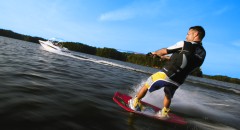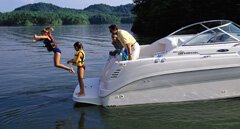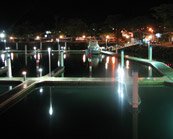The following is a glossary of wakeboarding and wakeskating terms.
- A-Frame: A term used to describe a slider or rail that has an up rail, horizontal rail, and down rail that makes the shape of the letter "A".
- Air: Getting in the air, the amount of space between the rider and the water.
- Air Trick: A trick performed using line tension for lift instead of the wake.
- Backside Boardslide/Lipslide: A Boardslide or Lipside where the rider approached the slider or wake with their back closest to the object being used.
- Backside Spin: A spin where the rider rotates with the back of their body towards the boat first. For a left-foot forward rider this would be clockwise. Sometimes mistakenly referred to as a "blindside spin".
- Bail: A term used to describe falling on your wakeboard.
- Ballast: Extra weight added to the boat to make the wake bigger. Ballast can be people, fat sacks, lead, or anything else that’s heavy. Some boats include Ballast systems which are built in systems that fill with water.
- Bindings: The rubber/foam boots that are attached the board to hold the board to the riders feet.
- Blind: Landing blind is also like landing wrapped, where the rider does not pass the handle so they land with the handle behind their back with their back facing the boat. Referred to like a "Tantrum to Blind", or "Front Flip to Blind". Sometimes backside spins are mistakenly referred to as "blind" spins.
- Board: A shorter version of "wakeboard".
- Boarder: A shorter version of "wakeboarder".
- Board Rack: A rack used for holding wakeboards and wakeskates. Usually attached to an extended pylon or tower.
- Boardslide: A slide on an obstacle or wake where the nose of the board is what travels over the obstacle. So if you approache a slider with your chest facing it and ollie up and slide with the nose over the slider, it’s a Frontside Boardslide.
- Boat: A wakeboarder or wakeskater is usually pulled by a motorized boat.
- Boat Speed: Refers to the speed the boat is going while pulling a wakeboarder. Most riders ride between 18-24 mph depending on rope length and skill level.
- Bone: To bone out a grab or bone out your leg means you straighten it all the way out. So I "boned out grab" is one where your leg or legs are straightened out while grabbing.
- Bonk: The act of touching/hitting your board on an obstacle. If a rider "bonks a buoy", they’re hitting their board agains the buoy briefly.
- Bunny Hop: Another term for Ollie. Bunny Hop comes from world of BMX biking, while Ollie is a term from skateboarding.
- Butt Check: When the rider lands a trick and drags or slaps their butt on the water. Generally this is considered a sloppy landing.
- Butter: A term used for smooth water.
- Cable: Cable wakeboarding is riding at a cable park instead of behind a boat. A cable park is a place where there are a series of mechanical cables connected by towers that pull the rider around the water. There are over 100 cable parks in the world, and they’re mainly in Europe.
- Case: To "case" the wake means to land right on top of the wake in an abrupt fashion.
- Choppy: A word used for rough water.
- Continuous Rocker: When the rocker of a board is continuous, meaning it has no flat spot in the center of the bottom of the board. This usually makes for a smoother pop and landing, but not as abrupt or vertical of a pop.
- Core: The inside material used in a wakeboard. Common cores are foam, honeycomb, or wood.
- Corked Spin: Another name for an off-axis spin. When a rider spins and the rider leaves their vertical axis and the board rises up to shoulder level or higher while spinning.
- Deep-Water Start: The normal way to start riding a wakeboard is to sit in deep water and let the boat start going and pull you up on top of the water.
- Digger: A bad wreck.
- Dock Start: One way for a rider to start riding, is to to a Dock Start. The rider can either stand and jump off the dock as the boat goes, or sit on the edge of the dock and slide off.
- Double-Up: When the boat circles around and cross back over it’s own wakes at about a 90-degree angle, the wakes converge causing the resulting wake to be twice the size. This is the Double-Up. If the rider times it right, they can edge in and hit the Double-Up, which will give them more air then normal.
- Duck: Sometimes called Duck-stance or Duck-foot, it’s referring to putting your front and back binding at even angles with your toes closer to the nose and tail of the board than your heels.
- Edge: The sides of the wakeboard are called edges. You have a Heelside Edge and a Toeside Edge on your board.
- EVA Foam: A lightweight foam used in bindings and rope handles.
- Extended Pylon: A pylon which is usually 6-feet tall or higher, used to attach the rope to so it’s higher off the water. A higher rope gives less downward pull on the rider while in the air.
- Eye-Opener: A fall where you faceplant so fast that you can’t manage to close your eyes before hitting the water. We don’t recommend falling this way.
- Faceplant: A fall where you catch your toeside edge causing you to fall very quickly so your face slaps the water hard.
- Fakie: A term from skateboarding that means riding the board in your normal riding position, but traveling the other direction. This can’t really be done in wakeboarding since you can’t change your foot position, so fakie is often interchanged with the term "Switchstance" in wakeboarding, which just means that the rider is riding the board with their opposite foot forward.
- Fat Sack: A sack that is filled with water and placed in the boat to make the wake bigger.
- Fin: A fin is the scag on the front and back of the board to help stabilize the board in the water.
- Flats: The section of the water outside of the wakes where the water is flat. If a rider does a big trick where they land way outside the wake, they’re doing a trick "out to the flats".
- Flip: The term can be interchanged with "Invert", but in wakeboarding a Flip is usually a term used to define a tip over tail upside down rotation. There are a few exceptions though.
- Frontside Boardslide/Lipslide: A Boardslide or Lipside where the rider approached the slider or wake with the front of their body closest to the object being used.
- Frontside Spin: A spin where the rider rotates with the front of their body towards the boat first. For a left-foot forward rider, this would be a spin in the counter-clockwise direction.
- Get Up: A term used for when the rider gets up out of the water and is riding the wakeboard standing up.
- Glass: A term for smooth water.
- Goofy Foot: Wakeboarders who ride with their right foot forward.
- Grab: While in the air, if the rider reaches down to the board and clasps their hand on it, it’s a "Grab". There are lots of different types of grabs that can be done alone or added to other tricks.
- Handle: The handle is at the end of the rope, and is usually between 12"-15" wide.
- Handle Pass: When the rope handle is passed from one hand to the other, it’s called a Handle Pass. It’s usually only used to referred to when the rider passes the handle behind their back.
- Heelside Edge: The Heelside Edge is the side of the board closest to your heels. Most riders are more comfortable edging with this edge when beginning.
- Helmet: A helmet is usually used when riders hit obstacles such as slider or kickers.
- Invert: When the rider goes upside down while in the air, it’s called an Invert.
- Jib: To hit a rail, slider, dock, etc. Basically riding/sliding something that isn’t water.
- Kevlar: A non-stretch material used in ropes similar to Spectra. Wakeboarders want a Kevlar or Spectra rope that doesn’t stretch.
- Kicker: A ramp hit by a wakeboarder or wakeskater to catch air.
- Life Jacket: A life vest or jacket is used to float the rider in the water.
- Lipslide: A slide on an obstacle or wake where the tail of the board travels over the obstacle first. So if you approach a slider with your chest facing it and ollie up and put the tail of the board over the obstacle, you’re doing a Frontside Lipslide.
- Loading the Line: This is a term used for building line tension in the rope when edging progressively. You want to "load the line" to build tension in the rope so it releases when you leave the wake to give you maximum pop.
- Lube: A slippery substanced used to help get your feet into bindings. There are some specially made lubes, but some people used shaving cream or soap.
- Mobe or Mobius: An invert that also contains at least a 360 degree spin in it.
- Molded Fins: Instead of conventional removeable fins, molded fins are actually fins shaped into the board out of the same material. They are usually shallower in nature.
- Monkey Spin: Another name for an off-axis spin. When a rider spins and the rider leaves their vertical axis and the board rises up to shoulder level or higher while spinning.
- Nose: The tip of the board, the closest end to the boat.
- Off-Axis Spin: When a rider does a spin but goes off the vertical axis so the board usually gets up to shoulder level or above.
- Ole’: When the rider does a spin and instead of passing the handle just lifts the handle over their head.
- Ollie: When the rider pops the board into the air by pushing down on their back foot and jumping up leading with their front foot. Just like a skateboarding ollie.
- Perfect Pass: Add-on to boats that allows the boat to keep a consistent speed for wakeboarding.
- Pop: This is when you release from the wake, you generate pop. Pop is also similar to the term "Air".
- Progressive Edge: The proper technique to be used when edging. A progressive edge is when the rider build their edge as they approach the wake so that their hardest edge is right when they hit the wake. See our Progressive Edge Trick Tip for more information.
- Pylon: A metal pole used for attaching the rope to the boat.
- Rail: A long rail made of metal, PVC, or wood used as an object to slide by a wakeboarder or wakeskater.
- Raley-Based Tricks: Tricks built off of the Raley, which means they are all tricks with your body extended back with the board above your head, yet aren’t inverted flips.
- Rampy Wake: A wake that has a very gradual slope to it. This type of wake is better for tricks where the rider edges all the way through the wake.
- Re-Entry: When the rider jumps off the wake and lands on the same wake. Often done off the rollers that cause a double up.
- Regular Foot: A rider who rides with their left foot forward on their wakeboard.
- Revert: Used to describe landing Switch or Fakie. A Roll To Revert is a Back Roll with a 180 causing the rider to land backwards, or Revert.
- Rider: Another name for the person riding the wakeboard.
- Rocker: The amount of curvature in a wakeboard. If a wakeboard has 2 inches of Rocker, then the tip and tail are 2 inches higher than the middle of the board. There are two types of rocker, continuous and three-stage. Continuous rocker is a smooth curve, while a board with three-stages of rocker, with a flat spot in the middle of the board.
- Roll: An invert where the board travels in an edge over edge rotation. However, some tricks that follow that rotation aren’t called Rolls, and a Back Roll has a tip over tail rotation, so it’s very confusing.
- Rope: The rope connects the handle to the boat. Common wakeboarding rope lengths are between 55’-80’.
- Set: A term used to refer to a wakeboarder taking their turn on the water. Each time you ride you’ve "taken a set".
- Slider: A long rail made of metal, PVC, or wood used as an object to slide by a wakeboarder or wakeskater.
- Spectra Rope: A spectra rope is one that is made out of the material called Spectra, which is a non-stretch substance. Wakeboarders want to use a non-stretch rope made of Spectra or Kevlar.
- Spin: A spin is when the rider and board rotate around on a vertical axis.
- Stack: Another term for a bad wreck.
- Standing Tall: When the rider is about to pop off the wake they want to stand tall, which means extending at the hips and knees so they don’t absorb the energy created by the impact of the wake.
- Stargazer: When doing a Raley or Raley-based trick and the nose of the board is pointing up towards the stars instead of pointing straight ahead as it should be.
- Steep Wake: A steep wake is a wake that is very abrupt and steep in shape. It’s closer to being a wall, and is better for tricks where the rider wants to stop and pop, or go up more instead of going out.
- Stomp: When a rider lands a trick in a smooth or clean manner, they have "stomped" the trick.
- Style: The look a rider has while riding. A unique style is a unique look to their ride. Things usually considered stylish are well-held grabs, smooth landings, tweaking out tricks, etc.
- Surface Trick: A trick performed with the board on the water the whole time.
- Switchstance: Riding the board backwards from your normal riding stance.
- Tail: The end of the board farthest from the boat when riding.
- Three-Stage Rocker: The type of board shape where there is a flat spot in the center of the board while the tip and tail curve up. This makes for a more abrupt/vertical pop and usually a slightly harder landing.
- Thumb Screws: These are screws used to screw the bindings onto the board. Other products used for this are Lokz, Hyperlocks, Bones, G-bolts, etc.
- Tip: The end of the board closest to the boat when riding.
- Toeside: The side of the board closest to the rider’s toes.
- Tower: A "cage-like" aluminum attachment to a boat used for tying the rope to, placing boardracks, speakers, etc.
- Trip Flip: A type of invert in which you approach the wake and a the base you allow the wake to trip you into the inverted motion.
- Triple-Up Just like a Double-Up, except the boat makes an additional kink which it drives back through to make a roller even bigger than a Double-up.
- Tweak: When a rider moves the board or legs while making a grab. Tweaking out a Method Grab means the rider would grab the board, then possibly bone out one leg.
- Vest: A life jacket, used to float the rider in the water.
- Wake: The wave created behind the boat which is used by a wakeboarder to jump of off or slide.
- Wake to Wake: When the rider does a trick where they take off from one wake, and land on the other, then the trick was "wake to wake".
- Wakeboard: The board a wakeboarder rides. Usually between 115 and 145 cm in length, and 15-17 inches wide.
- Wakeboarder: The person riding the wakeboard.
- Wakeskate: A combination of a wakeboard and a skateboard. The board doesn’t have bindings, is smaller, and covered with grip tape or a sticky foam.
- Washy Wake: A wake that isn’t very clean. This means that it’s sort of bumpy and there may be a white turbulent water on the top of the wake.
- Wedge: Invented by Malibu Boats, a large plate that lowers into the water off the back of the boat to pull the back of the boat deeper, and thus making a bigger/steeper wake.
- Wipe Out: A term used to describe a fall on a wakeboard.
- Wrapped: When the rider has the rope wrapped around their back when riding they are are going to perform a wrapped trick. It allows a rider to spin without doing a handle pass, so it allows for unique grabs.
-
Wreck: When the rider falls and can no longer hold on to the rope.
Content courtesy of http://wakeboarder.com
See Also:


